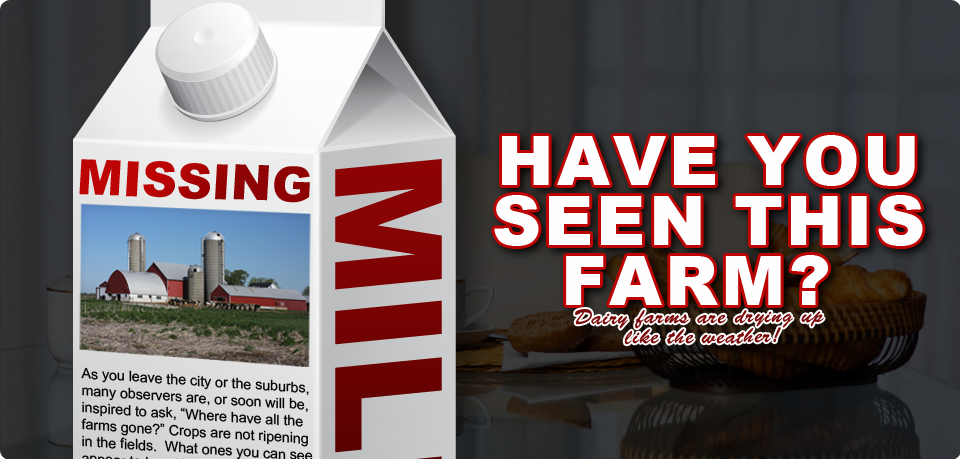As you leave the city or the suburbs, many observers are, or soon will be, inspired to ask, “Where have all the farms gone?” Crops are not ripening in the fields. What ones you can see, appear to be withering. There are fewer grazing herds! There are no busy harvest scenes.
The stories are different:
- “We put our prize winning dairy herd up for auction”
- “We had to sell out.”
- “We are facing bankruptcy.”
The results are the same:
- Farms are missing.
Some look at the recent weather change and indulge in “If only’s”. If only the storm had come a few weeks earlier. If only the drought had eased. If only we could have saved the cows. Regardless of what might have happened, the stark reality is that, with pastures so dry that in some places cattle had nothing to eat, farmers were losing money just trying to feed them.
Did They Give Up Too Easily or Too Soon?
Giving up are two words that don’t come easily to dairy farmers. They especially don’t come easily when three to five generations of one family have milked dairy cows on the same farm for several generations. One farmer who reluctantly had to sell nearly all of his cows at a livestock auction reports that they hung on for as long as they could “hoping that things would change” Unfortunately, it just didn’t happen.
What did happen?
Well it started with days, and in some places, weeks at a time, where temperatures settled at 100 degrees or above. There was no rain. Some places that did get a few drops found it wasn’t enough to penetrate the baked earth. These are only a few of the factors that created the most severe drought in fifty years. As a result, every single day, farms teeter on the brink of bankruptcy. Some go over. Each one of those farms was run by a real person with a name, a face, a family and a lifetime of memories. It’s easy to keep the disaster at arm’s length until you see the tears and hear the stories of broken dreams. This isn’t reality television which is absurd and easily forgotten or forgotten by simply changing the channel. This is real life and, eventually, it will affect more than just the single farm family.
It could touch YOU
A statistic that isn’t often put at the lead of the daily news stories is the fact that (Statistics on how many jobs depend on agricultural industry). This means that a lot of people are going to feel the effects in a very real way. It will start with the businesses in rural communities that depend on farmers to be their customers. For them it’s more than a news item – they worry it could cause retailers to become the next level to lose their business.
It Exacts a Terrible Toll
Some are trying to survive. They pray for rain and try to stay afloat financially, but at what cost? “It’s frightening” says one farmer. “I wake up many mornings and throw up. The drought has shot my nerves.” Even children are affected, “Are we going to have to sell all the animals?” There are tears and recriminations. “”We didn’t fail. We did everything right. It was the system that failed us.”
The Politics of Defeat
When your back is against the wall, it is human nature to look for help. Desperate farmers are looking for government help. This is not a natural source for people who are proud of their ability to survive come what may. The drought hasn’t changed that but with nowhere to turn, they are beginning to feel they are fighting a losing battle. They’re in the uncomfortable position of needing to ask for help. And they’re not necessarily getting it.
What’s Being Offered?
- Earlier this month, the Obama administration announced emergency drought assistance
- Low-interest emergency loans
- Federal buy-up of meat from livestock producers
- Opening up of some protected lands for livestock grazing
- None of those efforts are targeted at dairy farmers, however, dairy advocates say.
- In Missouri,
- the governor created a cost- share program to help farmers get access to water for their cattle
- Some see this as only a partial answer and not a full solution.
What’s Missing?
- The under secretary of the U.S. Department of Agriculture, Michael Scuse, says that dairy farmers have not been offered enough of a safety net because Congress has not finalized an omnibus piece of legislation called the Farm Bill.
- Several programs that deal with emergency assistance for livestock owners expired in September 2011;
- An insurance program for livestock producers will be cut further in September and eliminated by October 1 unless new legislation is passed.
- Earlier this summer, the U.S. Senate and the House’s agriculture committee passed versions of the five-year bill, which includes everything from food stamps to crop insurance. The House returns from August recess on September 10. The bill in its current form would create an insurance program specifically for dairy farmers. Currently, most dairy farmers are uninsured, according to officials and policy experts; that makes them more vulnerable to the impacts of a drought or high feed prices, both of which have taken hold now.
The BULLVINE Bottom Line
And so we drive down the road and wonder what is happening, who’s responsible and if there is any possibility for a brighter future. For the farm families who have lost everything, they cling to hope of some coordinated effort that will make a difference. Will the well loved family farm disappear and be forgotten? Another victim of the whims of weather and uncontrollable forces? “Have YOU seen this farm?”

















Well said, good post
I always wanted to be the biggest dairy in my county. Who knew it would come by being the last.